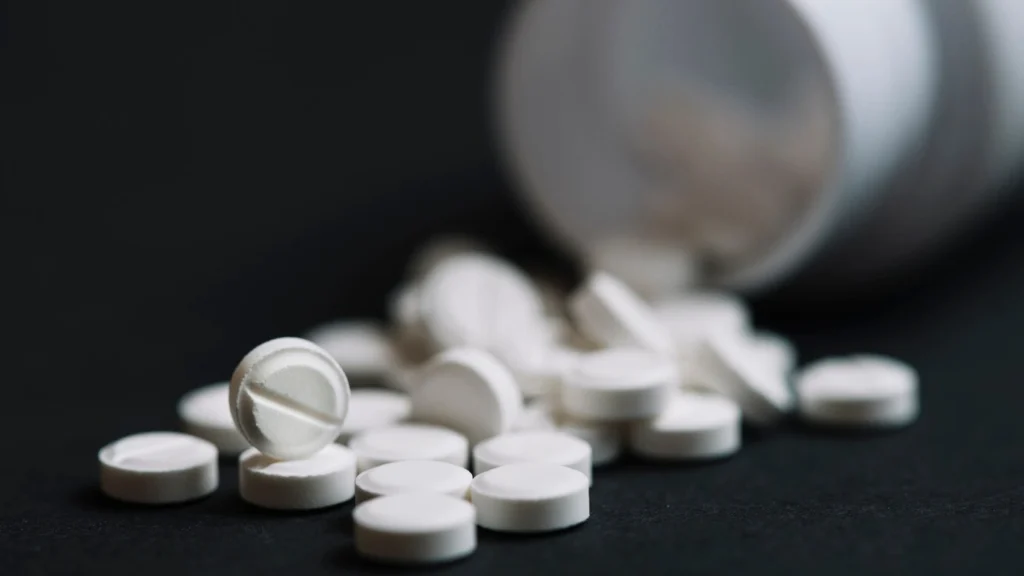
Addiction & Trauma Recovery Center
Licensed by Thai Ministry of Health #84-03-00294
Opioids: Addiction, Effects, and Treatment
What Are Opioids?
Opioids are a class of drugs used primarily for pain relief but have a high potential for addiction. These substances interact with opioid receptors in the brain, reducing pain while also creating feelings of euphoria. Opioid addiction has become a major public health crisis, leading to widespread dependence, overdoses, and fatalities worldwide.
Common Types of Opioids
- Prescription Opioids – Oxycodone (OxyContin, Percocet), Hydrocodone (Vicodin), Morphine, Codeine, Tramadol
- Illegal Opioids – Heroin, illicit Fentanyl, synthetic opioids
- Medication-Assisted Treatment Opioids – Methadone, Buprenorphine (Suboxone), used for recovery
While opioids are effective for short-term pain relief, long-term use can lead to dependency and life-threatening consequences.
Due to the dual nature of these substances: while they are highly effective in managing acute and chronic pain, their misuse can lead to devastating consequences. The opioid crisis, fueled by overprescription and the availability of illicit opioids like heroin and fentanyl, has resulted in a surge of addiction and overdose deaths.
For example, fentanyl, a synthetic opioid 50 to 100 times more potent than morphine, is often mixed with other drugs, increasing the risk of accidental overdose. Opioid addiction not only affects individuals but also places a significant burden on families, healthcare systems, and communities. Treatment for opioid addiction often involves a combination of Medication-Assisted Treatment (MAT), behavioral therapy, and support groups to address both the physical and psychological aspects of dependency.
Public health initiatives, such as increasing access to naloxone (an opioid overdose reversal drug) and promoting safer prescribing practices, are critical in combating this crisis. Understanding the risks and benefits of opioids is essential for preventing misuse and supporting those affected by addiction.

Short-Term and Long-Term Effects of Opioid Use
Understanding the effects of opioids is crucial for recognizing the risks of misuse and addiction.
Short-Term Effects of Opioids
- Pain relief and relaxation
- Drowsiness and sedation
- Euphoria or sense of well-being
- Nausea and vomiting
- Slowed breathing (respiratory depression)
Long-Term Effects of Opioid Use on Health
- Physical Dependence – The body becomes reliant on opioids to function normally.
- Increased Tolerance – Higher doses are required to achieve the same effect, increasing overdose risk.
- Brain Changes – Long-term use alters brain chemistry, making it difficult to quit.
- Mental Health Issues – Anxiety, depression, and cognitive decline.
- Organ Damage – Chronic opioid use can harm the liver, kidneys, and gastrointestinal system.
- Increased Overdose Risk – Many fatal overdoses involve opioid-laced drugs, especially fentanyl.
Even those using opioids as prescribed can develop dependence, highlighting the importance of responsible use and monitoring.
The effects can vary depending on factors such as the type of opioid, the duration of use, and the individual’s overall health. For instance, short-term effects like euphoria and pain relief can quickly lead to misuse, as individuals may seek to replicate these pleasurable sensations. Over time, the brain’s reward system becomes hijacked, leading to increased tolerance and physical dependence, where the body requires opioids to avoid withdrawal symptoms.
Long-term use can also result in significant changes to brain structure and function, impairing decision-making, memory, and emotional regulation. Additionally, the risk of overdose is heightened when opioids are combined with other substances, such as alcohol or benzodiazepines, which further depress the central nervous system.
This underscores the importance of educating individuals about the risks of opioid use, promoting safe prescribing practices, and providing access to treatment for those struggling with addiction. By addressing both the immediate and long-term consequences of opioid use, we can work toward reducing the devastating impact of the opioid crisis.

Signs of Opioid Addiction and Dependence
What Are the Common Signs of Opioid Addiction?
Recognizing opioid addiction early can improve recovery outcomes. Common signs include:
- Behavioral Changes – Secrecy, isolation, doctor shopping, missing obligations.
- Physical Symptoms – Constricted pupils, drowsiness, slurred speech.
- Psychological Signs – Mood swings, irritability, anxiety, depression.
- Increased Tolerance – Needing higher doses to feel the same effect.
- Withdrawal Symptoms – Experiencing discomfort when opioids are not taken.
Opioid dependence occurs when the body adapts to the drug, requiring continued use to avoid opioid withdrawal symptoms.
Behavioral changes like doctor shopping or stealing prescriptions often indicate a growing desperation to obtain opioids, while social withdrawal and neglect of responsibilities reflect the prioritization of drug use over relationships and daily activities. Physical symptoms, such as constricted pupils or slurred speech, are often accompanied by noticeable weight loss, poor hygiene, or frequent illnesses due to a weakened immune system.
Psychological signs, including mood swings and depression, can worsen over time as the brain’s chemistry becomes increasingly disrupted. Withdrawal symptoms, such as muscle aches, nausea, and severe cravings, can make quitting opioids incredibly challenging without professional help.
Recognizing these signs early and seeking intervention through medical treatment, therapy, and support groups can significantly improve the chances of recovery and reduce the risk of long-term health complications. Education and awareness are key to helping individuals and their loved ones identify opioid addiction and take proactive steps toward treatment.
The Opioid Withdrawal Process
What Are the Withdrawal Symptoms Associated With Opioids?
Withdrawal symptoms typically begin within 6-12 hours for short-acting opioids and within 30 hours for long-acting opioids.
Early Withdrawal Symptoms (6-24 hours)
- Anxiety and restlessness
- Muscle aches and joint pain
- Sweating and chills
- Runny nose and watery eyes
- Insomnia
Peak Withdrawal Symptoms (24-72 hours)
- Nausea, vomiting, diarrhea
- Abdominal cramps
- Rapid heartbeat and high blood pressure
- Severe drug cravings
How to Safely Detox from Opioids at Home
- Tapering Off Slowly – Reducing opioid use gradually under medical guidance can ease symptoms.
- Hydration & Nutrition – Drinking plenty of fluids and eating healthy can support recovery.
- Over-the-Counter Medications – Ibuprofen for pain, loperamide for diarrhea, and antihistamines for sleep.
- Medical Supervision – While some people detox at home, medically supervised detox is recommended for severe dependence.
In cases of severe addiction, medication-assisted treatment for opioids is often necessary.
Withdrawal symptoms, while not typically life-threatening, can be so severe that they drive individuals to relapse in order to find relief. For example, the intense cravings and physical discomfort during peak withdrawal can make it nearly impossible to quit without professional help.
Medically supervised detox, often involving medications like Methadone, Buprenorphine, or Clonidine, can significantly ease withdrawal symptoms and reduce the risk of relapse. Additionally, emotional support from loved ones, counseling, and participation in support groups can provide the motivation and accountability needed to navigate this difficult phase.
Detoxing at home may be an option for those with mild dependence, but it carries risks, such as inadequate symptom management or complications from underlying health conditions. By combining medical supervision with emotional and social support, individuals can safely detox from opioids and take the first step toward long-term recovery.
Treatment and Recovery Strategies
Overcoming drug addiction requires a combination of medical treatment, therapy, and lifestyle changes.
Here are the most effective methods:
Overcoming opioid addiction requires a multi-faceted approach that includes medical care, therapy, and long-term support.
Opioid Addiction Treatment Options and Success Rates
- Medical Detox – The first step in treatment, where patients withdraw under medical supervision to manage symptoms.
- Medication-Assisted Treatment (MAT) – FDA-approved medications help manage cravings and reduce relapse rates.
- Methadone – Reduces withdrawal symptoms and cravings.
- Buprenorphine (Suboxone, Subutex) – Blocks opioid effects while preventing withdrawal.
- Naltrexone (Vivitrol) – Prevents opioids from producing a high.
- Inpatient Rehab – Structured recovery programs with medical support, therapy, and relapse prevention strategies.
- Outpatient Programs – Allows patients to receive treatment while maintaining daily responsibilities.
- Behavioral Therapy – Cognitive Behavioral Therapy (CBT) helps individuals identify triggers and develop coping strategies.
- Support Groups – Narcotics Anonymous (NA) and 12-step programs provide community-based support.
How Does Medication-Assisted Treatment (MAT) Work for Opioids?
MAT combines behavioral therapy and medication to treat opioid addiction effectively. Studies show that MAT:
- Reduces opioid overdose deaths by 50%
- Improves long-term recovery success rates
- Prevents relapse and withdrawal symptoms
MAT is considered the gold standard for opioid recovery, helping individuals regain stability while working toward complete sobriety.
Someone with a long history of opioid use and co-occurring mental health disorders may benefit more from inpatient rehab combined with Medication-Assisted Treatment (MAT) and intensive behavioral therapy. On the other hand, individuals with milder addiction or strong support systems might find success in outpatient programs that allow them to continue working or caring for their families while receiving treatment. MAT, in particular, has revolutionized opioid addiction treatment by addressing both the physical and psychological aspects of dependency.
Medications like Buprenorphine and Methadone not only reduce cravings and withdrawal symptoms but also stabilize individuals, enabling them to focus on rebuilding their lives. Additionally, behavioral therapies like Cognitive Behavioral Therapy (CBT) and support groups like Narcotics Anonymous (NA) provide the tools and community needed to sustain long-term recovery.
By combining medical treatment with emotional and social support, individuals can achieve a holistic recovery that addresses all aspects of their well-being.

FAQs About Opioid Addiction
What are the common signs of opioid addiction?
Opioid addiction symptoms include increased tolerance, withdrawal symptoms, behavioral changes, and difficulty controlling use.
Behavioral changes, such as neglecting responsibilities, lying about drug use, or withdrawing from social activities, are often red flags that indicate a growing dependency. Additionally, individuals may experience mood swings, irritability, or depression as their brain chemistry becomes increasingly disrupted by prolonged opioid use.
Recognizing these signs early is crucial for seeking timely intervention, which can significantly improve recovery outcomes.
How does medication-assisted treatment (MAT) work for opioids?
MAT involves using medications like Methadone, Buprenorphine, and Naltrexone to reduce cravings and withdrawal symptoms, improving long-term recovery outcomes.
To explain the science behind these medications it is important to understand their role in stabilizing individuals during recovery. Methadone and Buprenorphine, for example, work by activating the same opioid receptors in the brain as other opioids but in a controlled manner, reducing cravings and withdrawal symptoms without producing the same euphoric high. This allows individuals to function normally while gradually reducing their dependence.
Naltrexone, on the other hand, blocks opioid receptors entirely, preventing opioids from producing any effects if they are used, which helps deter relapse. MAT is most effective when combined with behavioral therapy and support groups, as it addresses both the physical and psychological aspects of addiction.
What are the withdrawal symptoms associated with opioids?
Common symptoms include muscle pain, anxiety, nausea, diarrhea, and intense cravings. Symptoms peak within 72 hours and gradually subside.
Muscle pain and joint stiffness can be so severe that they make it difficult to move or sleep, while gastrointestinal symptoms like nausea, vomiting, and diarrhea can lead to dehydration and weakness if not properly managed. Anxiety and restlessness often accompany these physical symptoms, creating a sense of desperation that can drive individuals to relapse in order to find relief.
The intense cravings during withdrawal are particularly challenging, as they are both physical and psychological, making it difficult to resist the urge to use opioids again. Medically supervised detox, often involving medications like Methadone or Buprenorphine, can significantly ease these symptoms and reduce the risk of relapse. Understanding the severity of opioid withdrawal underscores the importance of seeking professional help rather than attempting to quit cold turkey.
Conclusion
Opioid addiction is a serious condition that requires medical attention and long-term support. The effects of opioids can be devastating, but with the right opioid addiction treatment options, recovery is possible.
If you or a loved one is struggling with opioid dependence, seek professional help immediately. Treatment, therapy, and medication-assisted treatment for opioids can provide the necessary tools for a successful recovery and a healthier future.
Recovery is a journey that requires ongoing commitment and support. Opioid addiction not only affects the individual but also has a profound impact on their families, relationships, and communities. Early intervention and comprehensive treatment, including Medication-Assisted Treatment (MAT), behavioral therapy, and support groups, can significantly improve recovery outcomes and reduce the risk of relapse.
For example, MAT helps stabilize individuals by reducing cravings and withdrawal symptoms, allowing them to focus on rebuilding their lives, while therapy addresses the underlying psychological factors that contribute to addiction. Support groups like Narcotics Anonymous (NA) provide a sense of community and accountability, which are essential for maintaining long-term sobriety.
By combining medical treatment with emotional and social support, individuals can achieve a holistic recovery that addresses all aspects of their well-being. Education and awareness about the risks of opioid use and the availability of effective treatments are key to combating the opioid crisis and helping individuals reclaim their lives.





















